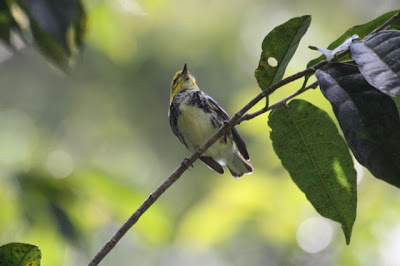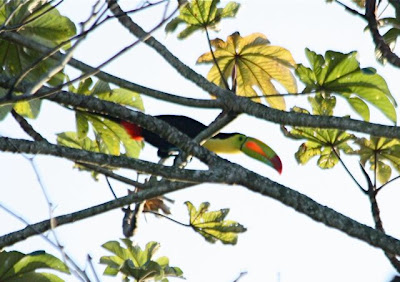Oh, that cooperative collared trogon. What a beauty he was. The first painting I saw that made me want to be a bird painter, that made me think I could really do it, was by my friend Alex when I was a freshman in college. It was of a collared trogon. So, while appreciating the bird, I blasted back in memory to that moment, seeing the way he'd laid a shadow across its tail, and realizing I could probably do that, too.
A lot has rolled out from that little epiphany.
There were some mighty fine smaller birds at Cerro Azul, too, and we had nice sunshine and drier air to enjoy them. Here's a golden-hooded tanager, Tangara larvata.
Let's have another look at that little beauty.
He was eating some tiny green fruits, balancing on the hair-fine twigs.
One of the big attractions of Cerro Azul Meambar is its hummingbird feeding station. Feeders are rigged up under the eaves of the visitor center. And we parked ourselves there and feasted our eyes.
Byron snaps a long-billed starthroat at close range.
White-bellied emeralds were confiding and common.
Much as I loved banging away at the feeder hummingbirds, I yearned to capture images of them in natural surroundings. So I wandered off to a patch of verbena and was well-rewarded by a cooperative rufous-tailed hummingbird.
Ahh. There's the shot I was after--feeding at real flowers!
A devilishly quick and difficult bird to capture is the long-tailed hermit, with its spectacular streamers. When it flies by, your brain just can't figure out what you've just seen, with these white dingies streaming out behind it and that scimitar bill before. It really wouldn't need the bandit mask.
But the jewel of Cerro Azul Meambar, the one they all come for, is the spectacular Violet Sabrewing. It comes thrumming into the feeders like a chimney swift, and by some miracle of iridescence it is purple in all lights and at all angles, not that frustrating blackish that so many hummingbirds seem to show.
This is a huge montane hummer, something like 6-7" long. Its wings make a correspondingly impressive low hum, so you know when it's around, and your heart just leaps.
I maneuvered around until I had the violet sabrewing against a soft green background; I wasn't wild about the babypoo yellow of the building as a backdrop for that glittering jewelbird.
Thank you, Violet Sabrewing.
Not far from the visitor's center, we ambled over to see the deluxe guest cottages under construction at Cerro Azul Meambar National Park. They were lovely, and the new lights outside attracted the most fabulous orthopterans and moths, a phenomenon that had not escaped this turquoise-browed motmot. He was cleaning up after the night's luminary siren had called innumerable large insects to bash themselves against the wall.
Mmm, katydid.
glug glug glug
Works every time. Ahhhh.
The next day, on the way down, I grabbed one of my favorite shots from the trip through the bus window. Catch the ears on that little boy.



























































